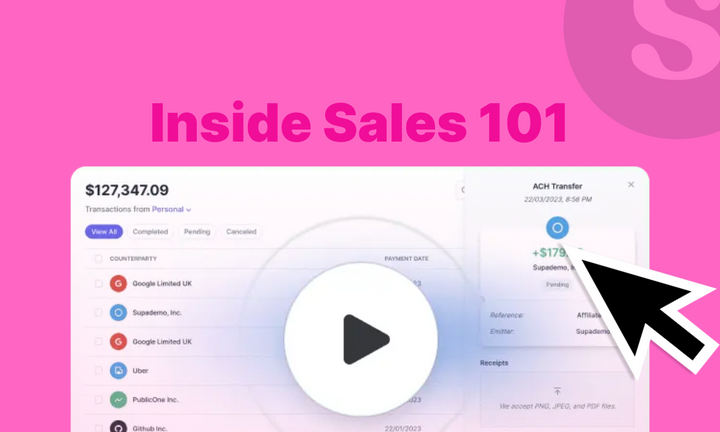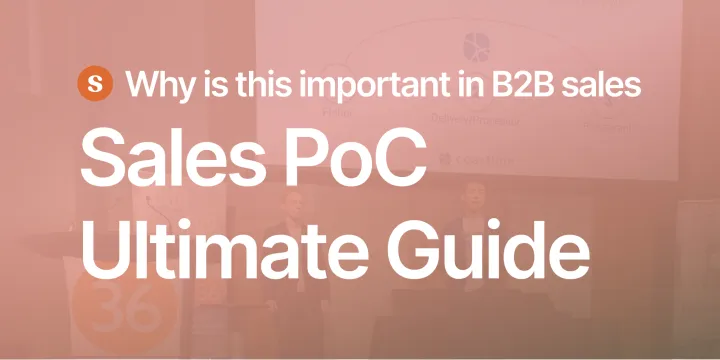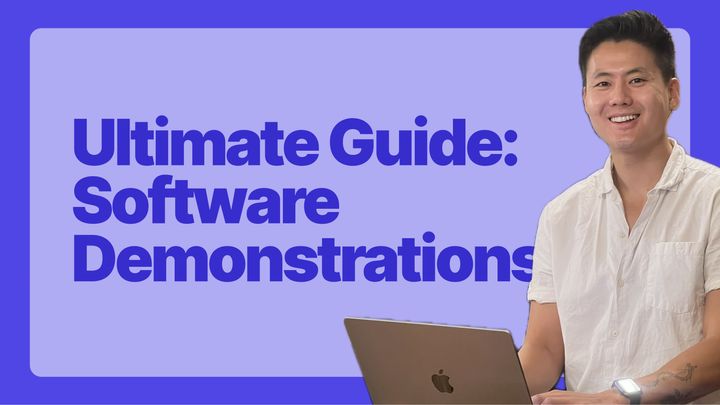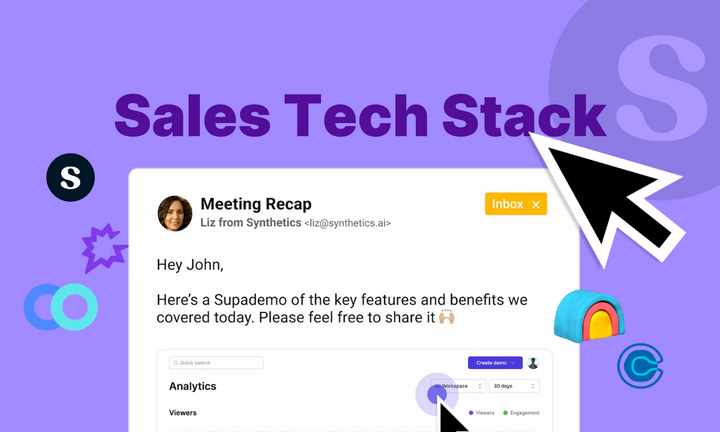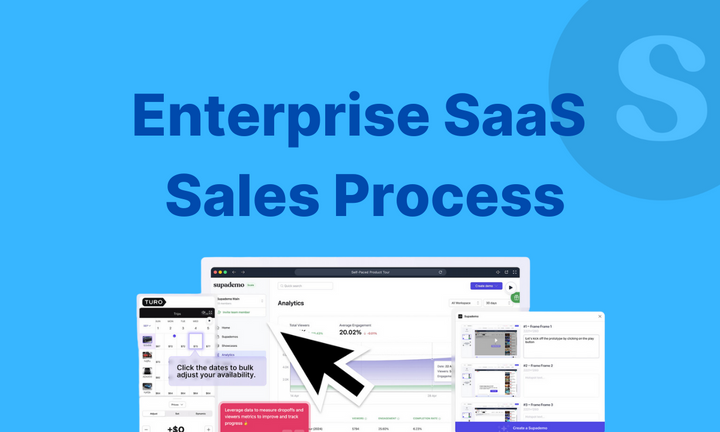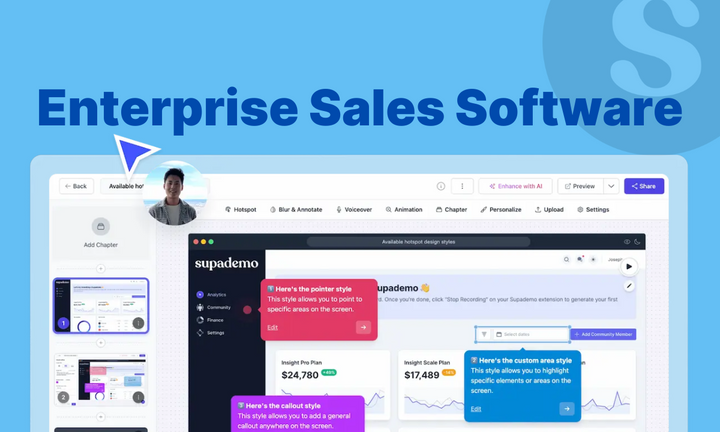B2B sales has come a long way.
While field visits and in-person meetings still matter, the rise of digital tools has made inside sales the default for SaaS and B2B tech companies.
It’s faster, more scalable, and fits today’s remote-first buyer journey.
In this guide, we’ll walk you through the benefits of inside sales, what challenges come with it, and how to build a team of high-performing inside sales reps.
What is B2B inside sales?
B2B inside sales is the process of selling products or services remotely using digital channels such as emails, social media, phone calls, and video conferencing.
The term “inside” refers to the fact that sales reps engage with buyers from within their office or home—unlike outside sales, where deals are closed through in-person meetings.
Because it’s digital-first, inside sales is the go-to for SaaS companies and B2B models with multiple stakeholders.
Consider this example:
Lara works remotely from her company’s New York HQ and gets a lead from a retail chain exploring a new inventory management software. She schedules a Zoom demo, tailors her pitch, and closes the deal via e-signature—without ever meeting the client in person.
Raj, on the other hand, handles outside sales. When he gets a similar lead, he drives to the client’s retail HQ in London, meets the operations head, conducts an on-site demo, builds rapport over coffee, and follows up in person to close the deal.
While the core goal of both types of sales is the same, the approach differs significantly.
Inside sales, as in Lara’s case, is highly scalable. She can reach hundreds of prospects through cold outreach and personalized emails. Outside sales, like Raj’s, is harder to scale due to the time and travel involved.
Here are some other differences between inside vs. outside sales.
Key benefits of B2B inside sales
B2B inside sales have surged in popularity—and for good reason.
Budget efficiency and scalability
Inside sales reps engage 4x more prospects at half the cost of a traditional field rep.
For example,
- Jane reaches out to 80 leads a week, books 20 demos, and closes 4 deals (~$50K ACV). Her monthly cost: $5,000
- Ron travels for on-site meetings, books 8 demos, and closes 2 larger deals (> $100K ACV). Monthly cost: $10,000
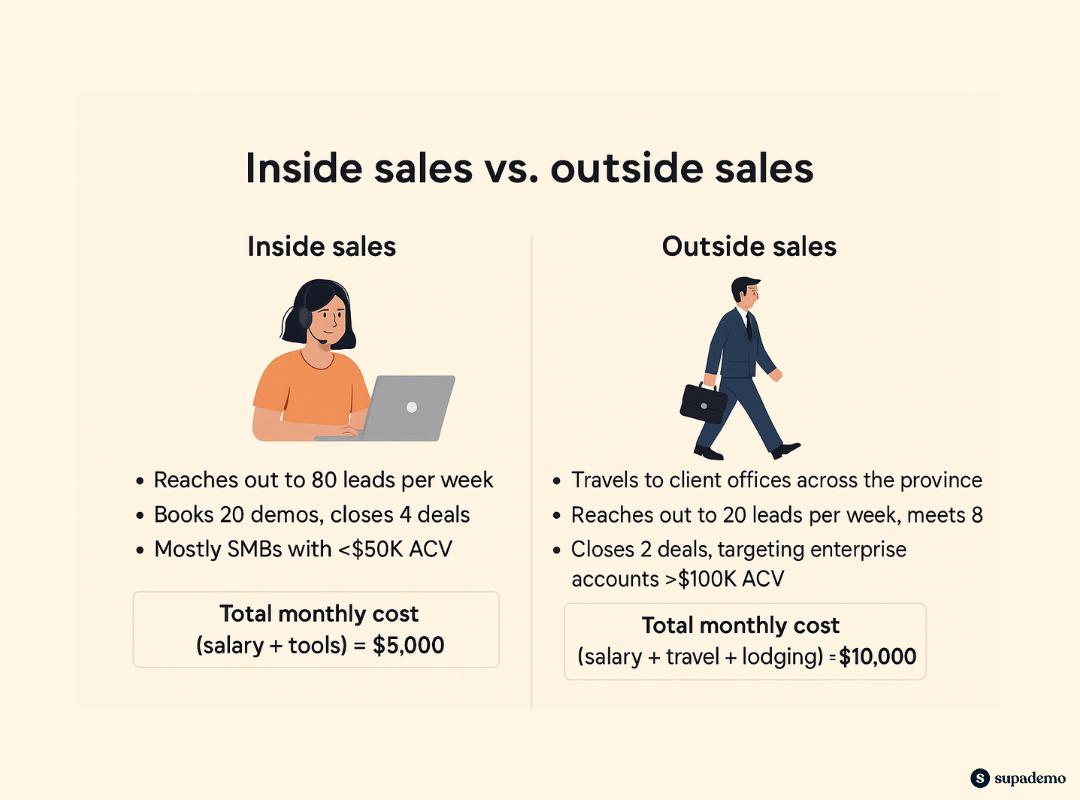
Since inside sales is remote-first, you spend more time actually selling. Combined with sales tools like CRMs and email automation, this model filters high-intent leads and keeps your cost-per-sale low.
More opportunities for training and coaching
As an inside sales rep, you work closely with your peers and managers, creating more opportunities for training and upskilling. Your manager can jump into a live call, observe objection handling, and give feedback instantly.
Additionally, conversation intelligence tools record each sales call, analyze the rep's performance across prospects, and generate personalized scorecards based on frameworks like BANT or SPIN. This enables managers to conduct personalized training sessions, and you get more tailored opportunities to learn and enhance your skill set.
Wider sales account reach
One of the biggest benefits of inside sales is that it isn’t confined to geography. A single rep can work leads across time zones—from Vancouver to New York to London—without leaving their desk.
Tools like CRM, sales automation, dialers, and LinkedIn allow teams to scale outreach, personalize campaigns, and manage hundreds of accounts with ease. Plus, since reps aren’t tied to territories, coverage and pipeline potential expand exponentially.
Greater deal closing predictability
This structure, paired with sales tools like CRM, email tracking, and conversation intelligence, gives you real-time insight into pipeline movement: who opened your email, who skipped the call, the number of proposals sent, and what objections came up.
You can spot patterns, forecast revenue, and optimize your approach based on what’s working.
In a nutshell, B2B inside sales offers a consistent, scalable, and productive approach to selling without the constraints of location, travel, or manual effort.
B2B inside sales strategies for success
Build a structured sales framework
Without a solid inside sales framework, your team risks playing telephone—everyone interpreting buyer signals differently and improvising their own playbook.
Frameworks like MEEDIC and CHAMP eliminate such ambiguity y creating a shared language for spotting real opportunities.
MEDDIC helps you dig deep into buyer motivation and decision-making. It stands for:
- Metrics – What goals or KPIs are they trying to improve?
- Economic Buyer – Can they approve the budget or connect you to someone who can?
- Decision Criteria – What matters most in picking a solution?
- Decision Process – How do they make buying decisions internally?
- Pain – What problem is driving them to look for a solution now?
- Champion – Who’s your internal supporter pushing for your product?
You can build a simple MEDDIC checklist in Notion or Google Docs or use platforms like Dock, which offers customizable templates.
Here’s one such example of Dock’s MEDDIC sales template.
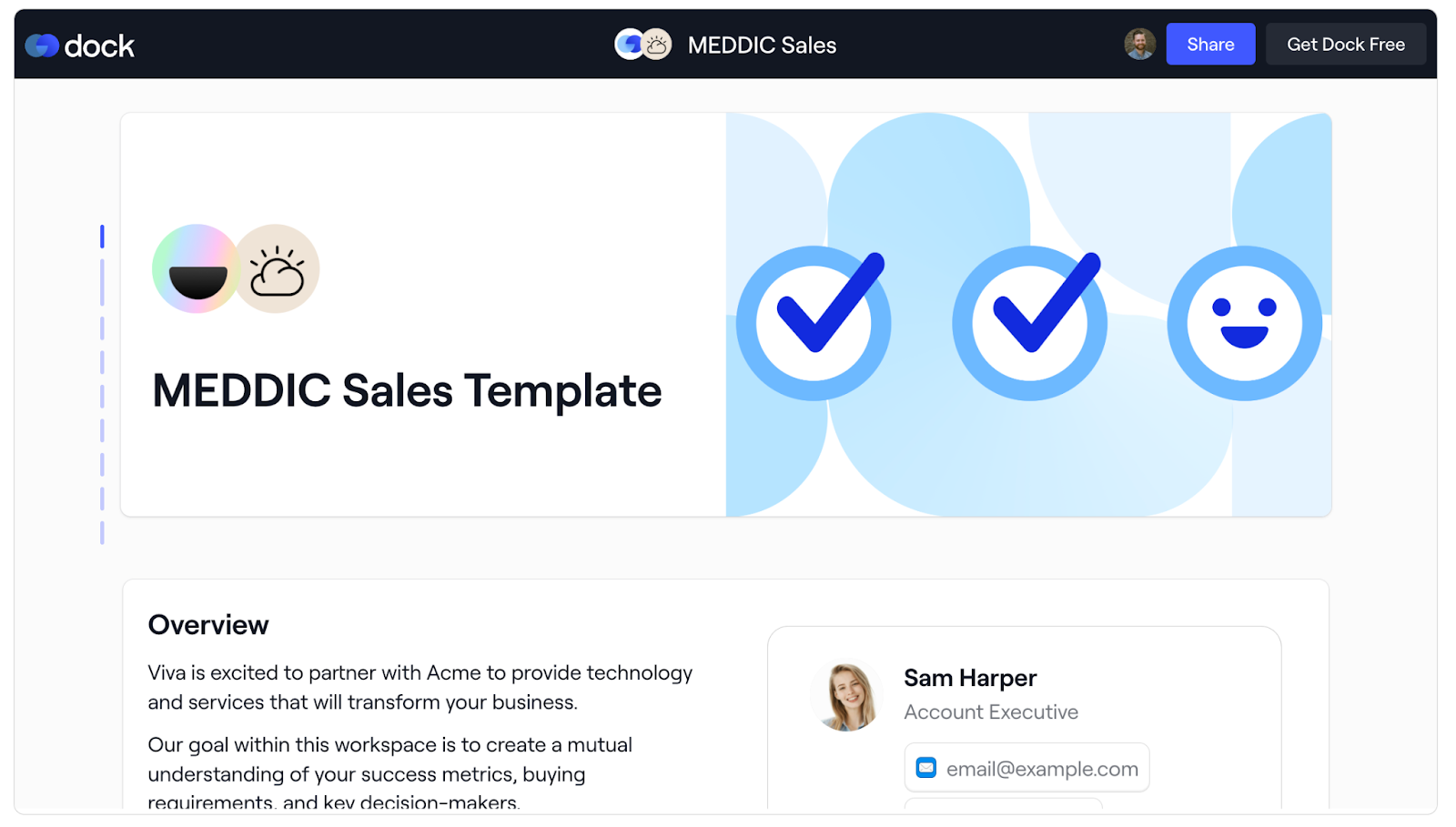
CHAMP is another sales framework that puts buyer urgency front and center:
- Challenges – What problems is the buyer trying to solve?
- Authority – Who is involved in the decision-making process?
- Money – Is there a budget allocated to solve this problem?
- Prioritization – How urgent is this need compared to other initiatives?
Similar to MEDDIC, you can use Google Docs to create a template for the CHAMP framework.
Here’s a CHAMP sales template we’ve built for you in Google Docs.

Lean into multi-channel outreach
With a shift towards digital interactions, prospects aren’t confined to a single channel.
They’re browsing LinkedIn during lunch, skimming newsletters at night, or responding to Slack messages from vendors. To succeed, your outreach needs to mirror this behavior.
Start by tailoring your sequences based on buyer behavior.
For instance:
- A cold lead might get a soft LinkedIn intro, followed by an email referencing mutual connections or relevant pain points.
- A warm lead who downloaded a case study might receive a direct email offering a personalized demo.
To build these sequences, use prospecting and sales intelligence tools like SalesLoft and Outreach. These tools help you map buyer’s engagement across channels and tailor your messaging accordingly.
A strong sequence includes:
- Clear number of touchpoints
- Defined time intervals
- Multi-channel messaging
- Flexible formats (text, video, voice notes, etc.)
This outbound sales sequence template by Nich Gegleski and Armand Forrokh, founder of 30 Minutes to the President’s Club, is a good starting point.
Here’s a brief overview of their multi-channel sales sequence.👇🏼
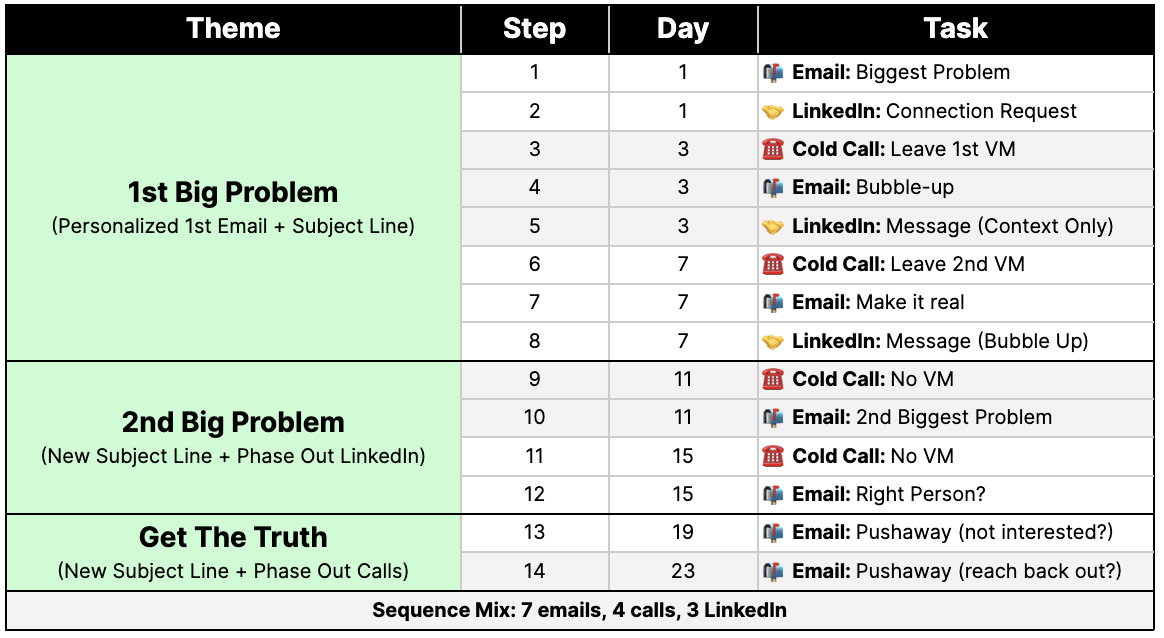
Don’t sleep on follow-ups
If you give up after one message, you’re leaving half-cooked deals on the table.
The B2B buying cycle is full of friction points: internal delays, budget shifts, and competing priorities. Consistent and relevant follow-ups keep the conversation (and momentum) alive.
But keep every follow-up message human and transparent.
For example, you can add a subtle message like, If I don’t hear back by next week, I’ll circle back. Does that work for you?
Use references from past conversations, product updates, or even mutual connections to keep the conversation relevant.
Need ideas? These 8 cold email follow-up templates from Gong are gold.
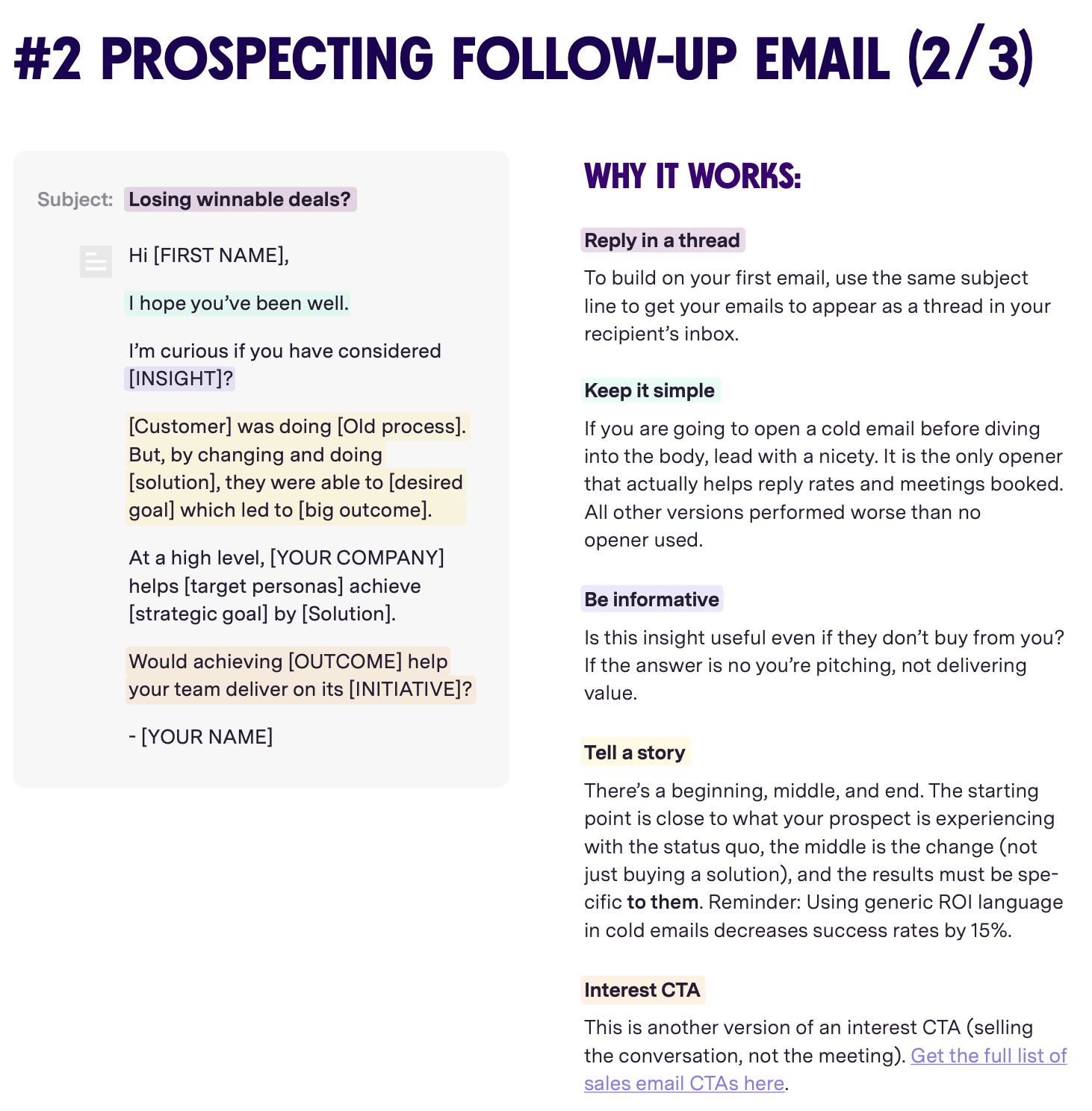
Better yet, include a follow-up interactive demo that highlights features discussed on the call. It bridges the gap between conversation and action.

Deliver value early with interactive product demos
Interactive demos are your secret weapon to stand out in generic pitches and conditional sign-ups.
These demos show (not only tell) why your product matters, reducing time-to-value and shortening the sales cycles.
👉 Learn more about how sales teams are improving efficiency with interactive demos in the State of Interactive Demos 2026 report.
It’s super easy to build and share such demos with Supademo. All you have to do is install the Chrome Extension and start recording the walkthrough of specific features. Once done, it automatically generates a ready-to-share demo with text descriptions, pixel-perfect images, and smooth transitions.
Every demo has multiple sharing capabilities.
Embed them on your website to drive engagement, share personalized URLs in your email outreach, or export them as PDFs, videos, or GIFs.
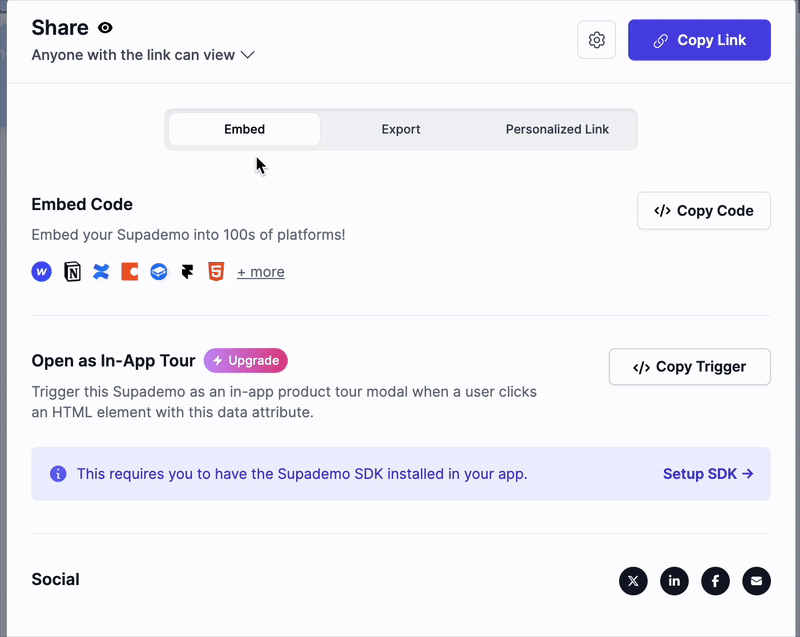
That’s not all.
As prospective buyers engage with the demo, they leave footprints. You’ll see which steps buyers engage with, where they drop off, and what piques their interest, giving you first-party data to tailor the next message.

Orbitax, a global tax platform, closed over $100K in deals using Supademo’s interactive walkthroughs alone. Read the full story here.
Build and leverage the right sales tech stack
Tracking buyer intent. Booking demos. Updating records. Managing pipelines. Inside sales involves dozens of such moving parts.
Without the right tools, it’s easy to miss high-intent signals or let leads slip through the cracks.
A reliable sales tech stack keeps everything in sync—from booking demos to updating CRM records.
We’ve outlined 15 must-have tools across the sales cycle—from data enrichment and outreach to deal collaboration and contract management. 👇🏼
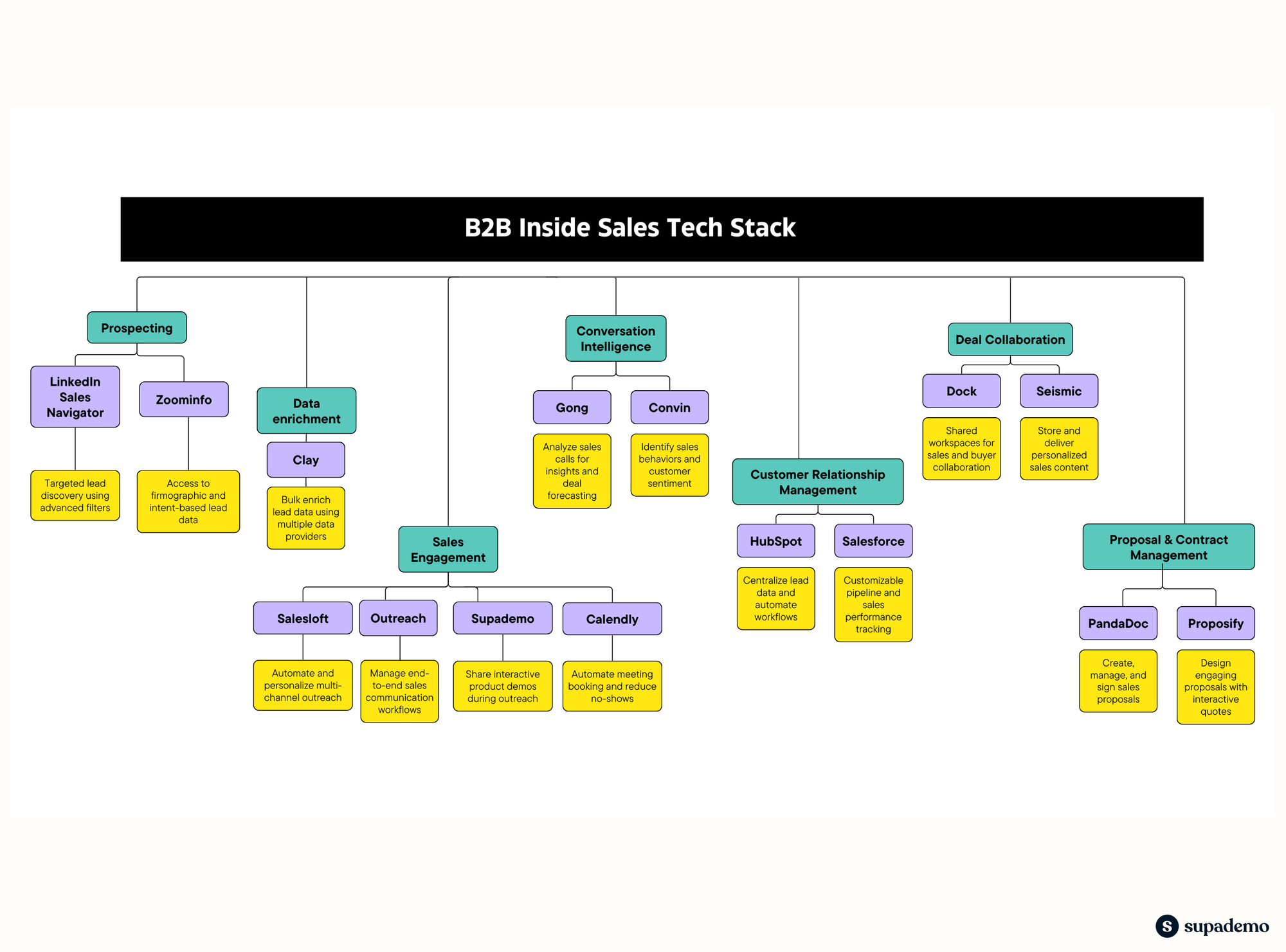
Common challenges in B2B inside sales (and how to overcome them)
Inside sales isn’t all sunshine and roses.
Selling through digital channels means your buyer’s attention is constantly under siege—from inbox clutter to endless vendor pitches.
Let’s see some common challenges you might encounter and how to overcome them.
Poor lead qualification
Getting hundreds of leads isn’t going to take you anywhere.
The real win lies in filtering high-intent buyers and focusing your energy on nurturing them.
But, the issue is lead qualification often hinges on inconsistent criteria or gut feeling, leading to missed opportunities and wasted effort.
Use structured frameworks like CHAMP (remember the one we discussed above?) and create lead scoring rubrics inside your CRM.
Here’s an example of a basic lead scoring model:
Such structured scoring helps your team rank and act on the most promising leads—fast.
Standing out in a crowded inbox
Your prospects are flooded daily with cold emails, LinkedIn DMs, and pitchy voicemails. If your outreach blends in, it’ll be ignored, no matter how many follow-ups you send.
To stand out, prioritize relevance over repetition.
- Personalize every message using insights from LinkedIn, CRM activity, and recent company news
- Craft curiosity-driven subject lines and outcome-oriented intros (e.g., “Cutting onboarding time by 30% for teams like yours”)
- Test different formats: short videos, voice notes, or GIFs, to add variety and make outreach more memorable
Kyle Coleman, current VP of Marketing at ClickUp and former Revenue Growth & Enablement head at Clari shares this fun activity to stand out — 5x5x5:
- Spend 5 minutes researching about the prospect
- Find 5 insights on the person/account
- Write your message in 5 minutes
He also shares that your subject line and the first line of the email should work in tandem.
Most email clients preview the first line as the preheader text. Use the subject line to evoke an emotional response and the opening line to continue the story.
Managing multiple touchpoints
Inside sales involves juggling dozens of conversations across email, calls, social DMs, and CRM tasks. Without a clear system, it’s easy to drop the ball on follow-ups, forget hot leads, or waste time on non-revenue tasks.
Use the Eisenhower Matrix to organize your daily workflow.
This method helps you sort tasks by urgency and importance so you can focus on what actually drives revenue.
Here’s what each quadrant should contain:
- Urgent + Important (Do) – Tasks with deadlines or consequences
- Important but not Urgent (Schedule) – Tasks with unclear deadlines but contribute to long-term success
- Urgent but not Important (Delegate) – Tasks that must be completed but doesn’t require your level of skills
- Neither (Eliminate or archive) – Unnecessary tasks
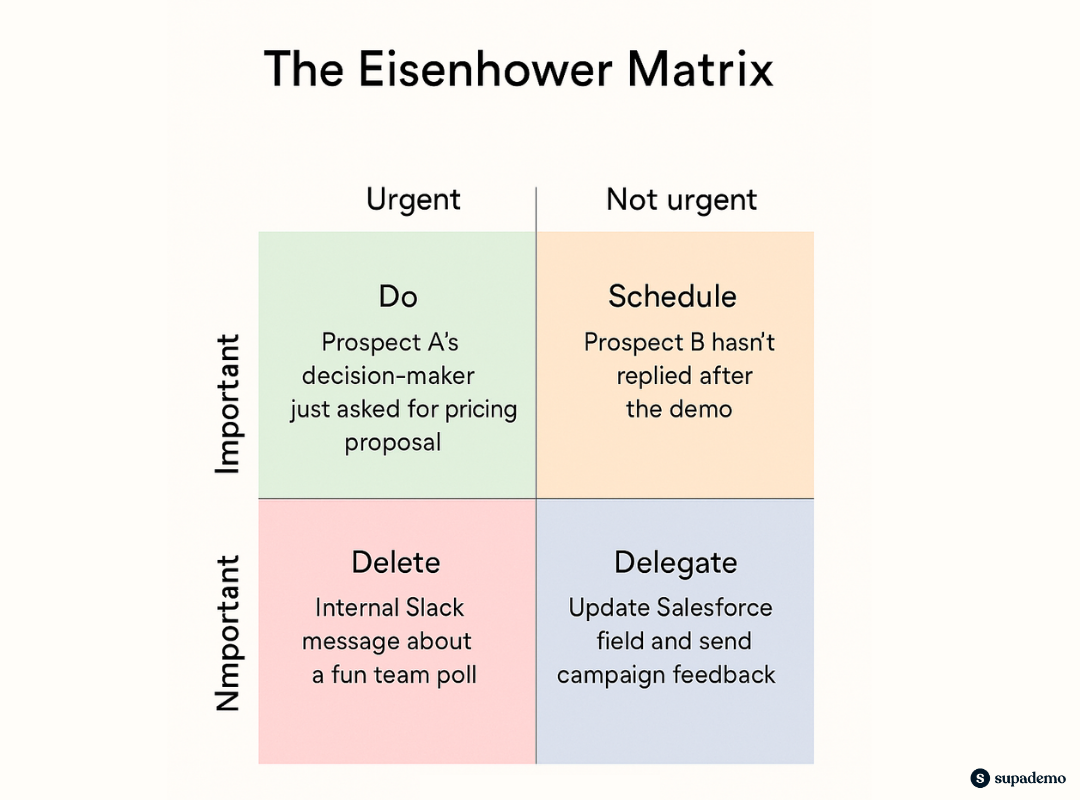
Best practices for high-performing inside sales teams
Building a top-performing inside sales team is a shared effort between reps and managers. Here’s what it takes from both sides:
For sales reps:
Collaborate across teams
Collaborate with your cross-department counterparts for customer insights, internal documents, and product roadmaps. For example, the marketing team can share insights on potential leads, while customer success can suggest upselling opportunities.
Set up regular sync-up calls or communicate in a shared Slack channel. You can also build a centralized hub like a sales digital room or Notion space) to store pitch decks, customer notes, and product updates
Master your sales tech stack
Know your tools—CRM, outreach platforms, and demo software—inside out.
The better you understand how each tool fits into your workflow, the more time you save and the benefits you get from it.
Don’t take learning for granted
Just like great writers sharpen their craft by reading others’ work, great sales reps grow by learning from the best. Shadow top-performing reps on calls, ask your manager what sets them apart, and analyze the strategies behind closed-won deals.
For sales managers:
Create a repeatable playbook
Your reps should never be guessing what to say next.
To enable your reps, create a living, searchable playbook that includes:
- ICP profiles and use case positioning
- Objection-handling frameworks
- Demo walkthroughs and FAQs
- Competitive battle cards
A simple Google Doc can house all your sales collateral. But you can always go with Notion or Guru to build a more structured playbook.
Motivate and engage remote sales reps
Build strong relationships with your reps.
Get to know them on an individual level. Ask questions like,
- What challenges do they face?
- When and how do they feel most motivated?
- What they’re good at and where do they need guidance?
- Are there any issues they’re facing in meeting their quota?
Gather this information via 1:1s, Slack chats, or anonymous surveys. And celebrate wins—whether it’s a Slack shoutout, team huddle mention, or a Champagne drop after closing a big deal.
The bottom line is: Care about your reps, and you’re on your way to building a team of high-closers.

Create a feedback loop for consistent growth
Run performance reviews and share constructive feedback. Here are some suggestions:
- Review sales calls and highlight areas for improvements (Conversation intelligence tools are your best friend for this)
- Track metrics like win rates, deal velocity, and conversion points
- Ask your reps what’s working and what’s broken
To create high performers, you need to build a system that supports reps' continuous learning and growth.
Hybrid sales: Blending inside and outside sales approach
Inside sales shine when it comes to SMBs and mid-market deals that can be closed through digital touchpoints.
But for larger, strategic accounts? A hybrid approach is the winning way.
The future of B2B sales lies in inside sales working in tandem with outside sales.
According to McKinsey, up to 80% of lower- to mid-value accounts can be closed remotely. The remaining high-value deals, however, often benefit from in-person interactions like on-site demos, executive meetings, or hosted events.
To make hybrid selling work:
- Segment your pipeline by deal size and complexity
- Assign outreach channels accordingly (Zoom demos for SMBs, in-person visits for high-stakes enterprise accounts)
- Blend digital and physical touchpoints for a cohesive experience
To win in in-person events such as industry conferences or trade shows, use interactive demos to bring your product to life.
Try Supademo for free to create interactive product walkthroughs tailored to each buyer. It’s a powerful way to add clarity and wow factor, whether you’re across the table or across the world.


